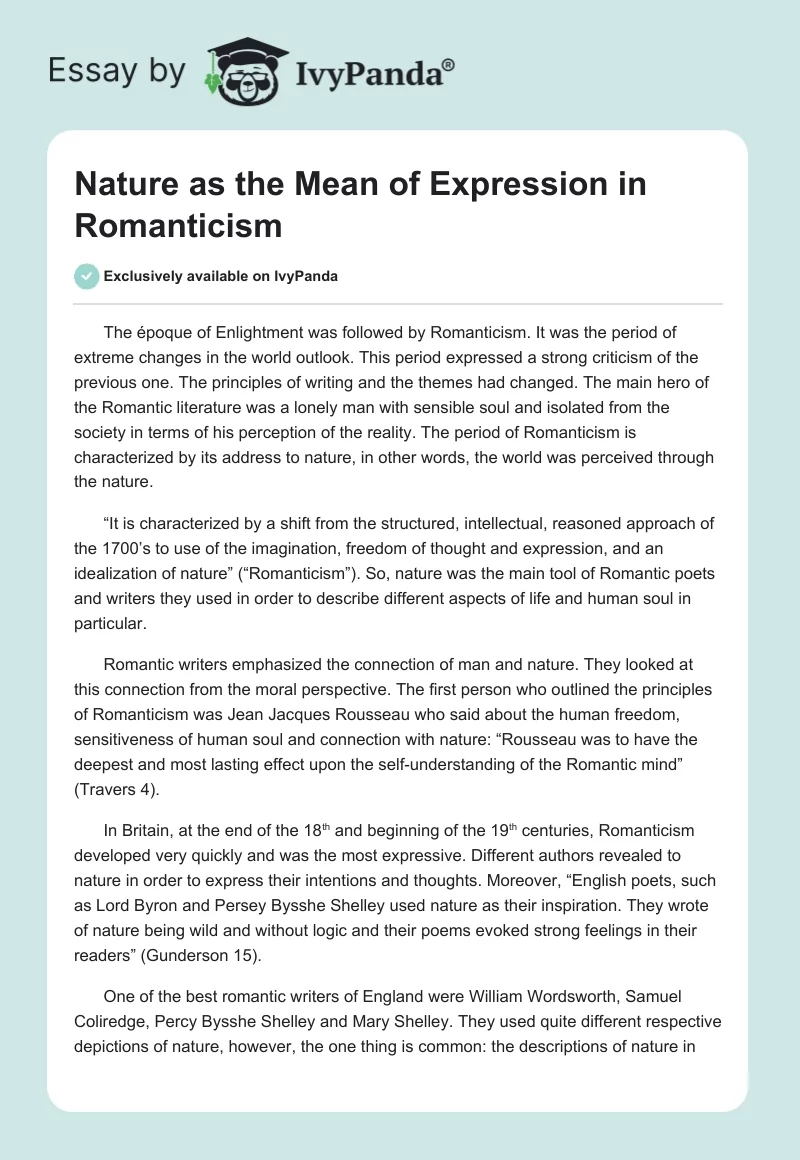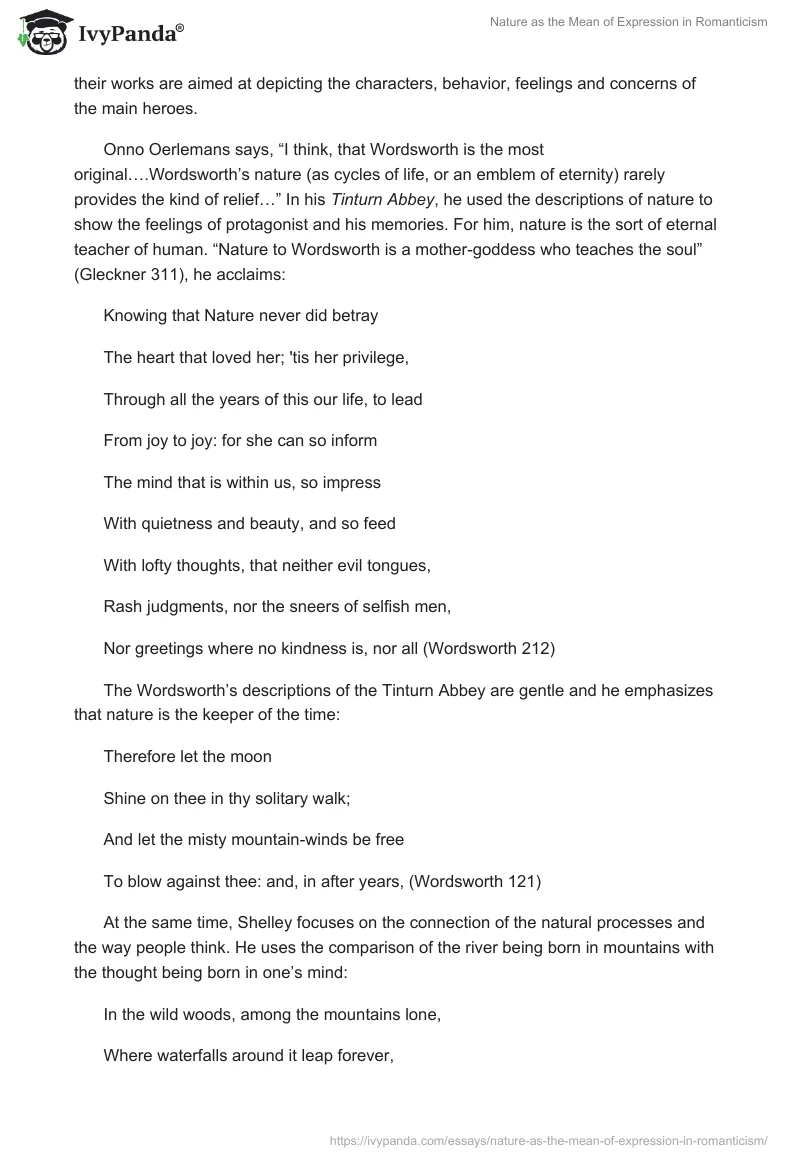The époque of Enlightment was followed by Romanticism. It was the period of extreme changes in the world outlook. This period expressed a strong criticism of the previous one. The principles of writing and the themes had changed. The main hero of the Romantic literature was a lonely man with sensible soul and isolated from the society in terms of his perception of the reality. The period of Romanticism is characterized by its address to nature, in other words, the world was perceived through the nature.
“It is characterized by a shift from the structured, intellectual, reasoned approach of the 1700’s to use of the imagination, freedom of thought and expression, and an idealization of nature” (“Romanticism”). So, nature was the main tool of Romantic poets and writers they used in order to describe different aspects of life and human soul in particular.
Romantic writers emphasized the connection of man and nature. They looked at this connection from the moral perspective. The first person who outlined the principles of Romanticism was Jean Jacques Rousseau who said about the human freedom, sensitiveness of human soul and connection with nature: “Rousseau was to have the deepest and most lasting effect upon the self-understanding of the Romantic mind” (Travers 4).
In Britain, at the end of the 18th and beginning of the 19th centuries, Romanticism developed very quickly and was the most expressive. Different authors revealed to nature in order to express their intentions and thoughts. Moreover, “English poets, such as Lord Byron and Persey Bysshe Shelley used nature as their inspiration. They wrote of nature being wild and without logic and their poems evoked strong feelings in their readers” (Gunderson 15).
One of the best romantic writers of England were William Wordsworth, Samuel Coliredge, Percy Bysshe Shelley and Mary Shelley. They used quite different respective depictions of nature, however, the one thing is common: the descriptions of nature in their works are aimed at depicting the characters, behavior, feelings and concerns of the main heroes.
Onno Oerlemans says, “I think, that Wordsworth is the most original….Wordsworth’s nature (as cycles of life, or an emblem of eternity) rarely provides the kind of relief…” In his Tinturn Abbey, he used the descriptions of nature to show the feelings of protagonist and his memories. For him, nature is the sort of eternal teacher of human. “Nature to Wordsworth is a mother-goddess who teaches the soul” (Gleckner 311), he acclaims:
Knowing that Nature never did betray
The heart that loved her; ’tis her privilege,
Through all the years of this our life, to lead
From joy to joy: for she can so inform
The mind that is within us, so impress
With quietness and beauty, and so feed
With lofty thoughts, that neither evil tongues,
Rash judgments, nor the sneers of selfish men,
Nor greetings where no kindness is, nor all (Wordsworth 212)
The Wordsworth’s descriptions of the Tinturn Abbey are gentle and he emphasizes that nature is the keeper of the time:
Therefore let the moon
Shine on thee in thy solitary walk;
And let the misty mountain-winds be free
To blow against thee: and, in after years, (Wordsworth 121)
At the same time, Shelley focuses on the connection of the natural processes and the way people think. He uses the comparison of the river being born in mountains with the thought being born in one’s mind:
In the wild woods, among the mountains lone,
Where waterfalls around it leap forever,
Where woods and winds contend, and a vast river 10
Over its rocks ceaselessly bursts and raves (Shelley 64)
Moreover, he uses the descriptions of a “dark valley” that produces the effect of trans on the reader. The epithets and images they create evoke deep emotions in readers. In Samuel Coleridge’s Rime of the Ancient Mariner, one can see the descriptions of the sea. The storm and the dead calm of the sea are the main means to reveal the essence of the story.
Moreover, the author uses the bird albatross as a metaphor that meant “the will of God” and sometimes compared with the symbol death. The images of nature in work of every author are quite different, Wordsworth describes it gently using special epithets; Shelley uses the images of nature in order to show the flow of time and his sorrow, his pictures are more dark and ferocious. Coleridge describes the sea, and even when it is calm, it still evokes horror and foreboding of evil.
One more wonderful writer of the period of Romanism is Mary Shelley with her famous Frankenstein. This writer is probably the one who used the images of nature in order to reveal every single thought and emotion of one of the main characters Victor.
The author uses natural phenomena metaphorically in order to describe Victor’s early years: “I find it arise, like a mountain river, from ignoble and almost forgotten sources; but swelling as it proceeded, it became the torrent which, in its course, has swept away all my hopes and joys” (Shelley, 21). In addition, every Victor’s emotion is connected with nature. The nature is one that helps him to survive horrible moments in his life.
To sum up it all, it should be mentioned one more time that nature and its images served as the main tool for the writers of Romanticism. They perceived the world through the nature and searched answers for eternal questions of being. Finally, all romantic writers were great masters of description.
Works Cited
Gleckner, Robert, Gerald E. Enscoe. Romanticism: points of view. USA: Wayne State University Press, 1974.Print
Gunderson, Jessica. Romanticism. Minnesota: Creative Education, 2008. Print
Oerlemans, Onno. Romanticism and the Materiality of Nature. London: University of Toronto Press. Inc, 2002. Print
“Romanticism.” Online Encyclopedia 2007. Microsoft Encarta, Microsoft Corporation, n. d.
Shelley, Mary. Frankenstein. United States of America: Dover Publications, Inc, 1994
Shelley, Percy Bysshe. The Complete Poetical Works of Percy Bysshe Shelley. Volume 2. BiblioBazzar, LLC, 2000. Print
Travers, Martin. European Literature from Romanticism to Postmodernism: A Reader in Aesthetic. New York NY, 2001. Pront
Wordsworth, William. The Major Works. New York: Oxford University Press, Inc, 2000. Print


